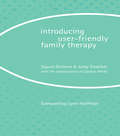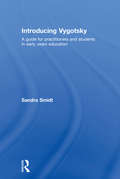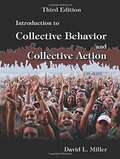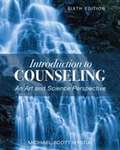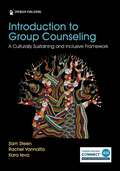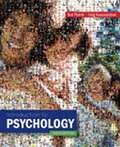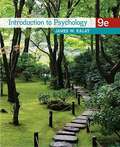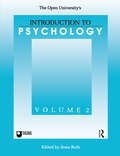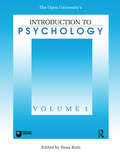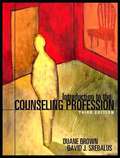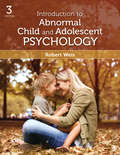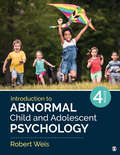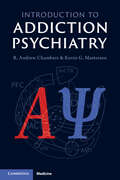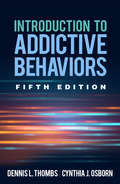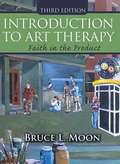- Table View
- List View
Introducing User-Friendly Family Therapy
by Sigurd Reimers Andy TreacherAll too often the experience of users of family therapy is neglected in the theory and practice of family therapy as well as in the literature itself. In Introducing User-Friendly Family Therapy the authors describe in detail how the results of an action research project helped the professionals involved to modify their practice. They draw out the implications of the research for providing a genuinely user-friendly service and set the arguments for a more humanistic approach in the wider context of contemporary social policy.Thought-provoking and practical in emphasis, this book places the user at the centre of the stage and insists that family therapy can only flourish if it becomes genuinely empowering and user-friendly.
Introducing Vygotsky: A Guide for Practitioners and Students in Early Years Education (Introducing Early Years Thinkers)
by Sandra SmidtSandra Smidt takes the reader on a journey through the key concepts of Lev Vygotsky, one of the twentieth century’s most influential theorists in the field of early education. His ground-breaking principles of early learning and teaching are unpicked here using every-day language, and critical links between his fascinating ideas are revealed. Introducing Vygotsky is an invaluable companion for anyone involved with children in the early years. The introduction of Vygotsky’s key concepts is followed by discussion of the implications of these for teaching and learning. Each chapter also includes a useful glossary of terms. This accessible text is illustrated throughout with examples drawn from real-life early years settings and the concepts discussed include: mediation and memory culture and cultural tools mental functions language, concepts and thinking activity theory play and meaning. Essential reading for all those interested in or working with children, Introducing Vygotsky emphasises the social nature of learning and examines the importance of issues such as culture, history, language, and symbols in learning.
Introducing the Clinical Work of Wilfred Bion (The Routledge Wilfred R. Bion Studies Book Series)
by Joseph AguayoIntroducing the Clinical Work of Wilfred Bion takes a fresh approach to this much revered analyst, focusing on the unique contributions to be found in his analytical and supervisorial work and developing of received Kleinian theory. Starting from his childhood in India and his schooldays, through his experience in the Great War and later life, this book considers the way in which Bion’s personal experience informed his later work as an analyst. Aguayo looks at how Bion’s loyalty to Kleinian theory, especially in his work on psychosis, and how the subsequent in-fighting rife within the psychoanalytic community impacted his approach. Aguayo also considers the epistemological work done by Bion in the early 1960s while President of the British Psychoanalytical Society, as well as his seminars from Los Angeles and Buenos Aires. The book concludes by proposing that the spate of recently published Clinical Seminars, fresh with new clinical examples from Bion’s analytic and supervisory work, now represent a potential for a ‘new wave’ of interest among analysts and scholars alike. Aguayo also engages the work of important contemporary specialists in Bion studies, such as: Ron Britton, Giuseppe Civitarese, James Grotstein, Robert Hinshelwood, Betty Joseph, John Steiner and Rudi Vermote. As Bion’s clinical work continues to inform contemporary psychoanalysts, this book will be essential reading to all analysts interested in Bion’s work and the legacy it holds in contemporary psychoanalysis.
Introduction To 21st Century Counseling: A Multicultural And Social Justice Approach
by Joel M. Filmore S. Kent Butler Anna Flores LockeIntroduction to 21st Century Counseling: A Multicultural and Social Justice Approach provides readers with an overview of the counseling discipline with emphasis on developing a culturally responsive practice rooted in social justice. Featuring chapters authored by seasoned experts and rising stars in the counseling profession, the text offers traditional information integrated with evidence-based techniques and practices based upon key multicultural and social justice competencies.
Introduction To Art Therapy: Sources And Resources
by Judith A. RubinIntroduction to Art Therapy: Sources and Resources, is the thoroughly updated and revised second edition of Judith Rubin's landmark 1999 text, the first to describe the history of art in both assessment and therapy, and to clarify the differences between artists or teachers who provide "therapeutic" art activities, psychologists or social workers who request drawings, and those who are trained as art therapists to do a kind of work which is similar, but qualitatively different. <P><P>This new edition contains a DVD-ROM with over 400 still images and 250 edited video clips for much richer illustration than is possible with figures alone; an additional chapter describing the work that art therapists do; and new material on education with updated information on standards, ethics, and informing others. <P>To further make the information accessible to practitioners, students, and teachers, the author has included a section on treatment planning and evaluation, an updated list of resources - selected professional associations and proceedings - references, expanded citations, and clinical vignettes and illustrations. <P>Three key chapters describe and expand the work that art therapists do: "People We Help," deals with all ages; "Problems We Treat," focuses on different disorders and disabilities; and "Places We Practice," reflects the expansion of art therapy beyond its original home in psychiatry. <P>The author's own introduction to the therapeutic power of art - as a person, a worker, and a parent - will resonate with both experienced and novice readers alike. Most importantly, however, this book provides a definition of art therapy that contains its history, diversity, challenges, and accomplishments.
Introduction To Clinical Psychology
by Douglas Bernstein Vicky Phares Geoffrey KramerDesigned to provide a thorough survey of the field that is equally accessible to students with a general interest as well as to those with professional aspirations, this text presents a scholarly portrayal of the history, content, professional functions, and the future of clinical psychology.
Introduction To Collective Behavior And Collective Action
by David L. MillerDavid Miller's expanded third edition makes it the definitive source on collective behavior and collective action. Up-to-date and meticulously researched, this popular volume continues to provide a systematic overview of theory and research. Each topic is meaningfully linked to the appropriate theories of collective behavior (mass hysteria, emergent-norm, and value-added perspectives) and collective action (social-behavioral interactionist, resource mobilization, and perception control perspectives). Rumor, mass hysteria, fads and fashion, UFOs, sports, migrations, disasters, riots, protest, and social movements are among the topics presented in a unique side-by-side presentation of the two disciplines. In an engaging, accessible style, Miller offers detailed discussion of classic sociological studies interspersed with intriguing modern-day examples that students will enjoy reading. His thorough topical treatment effectively reduces the need for outside readings. New to this edition: A new emphasis on the impact of social media, technology, and citizen journalism on social movements, including resource mobilization, rumor and communication, disaster response, and documentation of human rights abuses and political protest such as the Arab Spring, the Tea Party movement, and the Occupy movement. Comprehensive discussion of economic globalization, the alter-globalization movement, and transnational activism, including the strategic incapacitation approach to the policing of large global demonstrations. Insightful analysis and application of the latest egress-modeling and crowd-control computer simulations and qualitative data-analysis software. Improved graphics and new photos that enhance the author's updated treatment, and an intriguing appendix on the social psychology of George Herbert Mead by collective behavior/collective action authority and crowd behavior expert Clark McPhail.
Introduction To Counseling: An Art And Science Perspective
by Michael NystulIntroduction to Counseling: An Art and Science Perspective provides students with an accessible overview of the counseling profession and also demonstrates how fundamental counseling concepts can be employed to successfully address everyday life challenges. The book posits that counseling is both an art and a science, highlighting the balance between the subjective and objective dimensions of counseling. <p><p> The first part of the book offers students an introduction to the counseling profession and the counseling process, introducing them to conceptual models for counseling, legal and ethical issues, and assessment, research, and evaluation. The second part of the text provides information on multicultural counseling and counseling theories, emphasizing models that are inclusive and adaptive. The final part of the text identifies special approaches and modalities that are helpful in the treatment of diverse populations in particular settings, including children and adolescents in school settings, individuals with mental health issues in hospitals, clinics, and private practices, and more. <p> The sixth edition of Introduction to Counseling features increased focus on professional identity of counselors, content on wellness and positive psychology, increased focus and awareness of social justice issues and advocacy as important dimensions of multicultural counseling, new information on technology-assisted methods of counseling, increased focus on the role of neuroscience in counseling, updated information on the changes in ethical codes, and new guidelines for diagnosis in DSM-5. Presenting timely and critical information in an approachable way, the text is a valuable resource for undergraduate and graduate-level students pursuing helping professions.
Introduction To Culturally Sustaining Group Counseling: An Inclusive Framework
by Sam Steen Kara Ieva Rachel VannattaThe only group counseling text to embrace multicultural and social justice considerations This innovative text is the first to integrate the constructs of multiculturalism, social justice, intersectionality, and advocacy within fundamental group counseling principles. Interweaving group theory with application, this clear and concise book is distinguished by a multitude of real-world case studies covering a broad spectrum of group leaders, co-leaders, and group members in different settings to demonstrate the knowledge, skills, and practices required for effective group counseling in all arenas. These case studies underscore the nuances of group counseling dynamics through an anti-racist, multicultural lens. Challenging antiquated theories and models, the text focuses on the strengths of innovative group counseling models and programs. Specific discussions of ethical considerations and multicultural and social justice counseling competencies for group workers are included in each chapter, along with multiple opportunities for experiential learning including discussion questions, small group activities, skill application, journal starters, and homework activities. An extensive suite of ancillaries includes an Instructor’s Manual, Test Bank, PowerPoints, and Podcasts. Purchase includes digital access for use on most mobile devices or computers. Key Features: Integrates multiculturalism competencies and social justice concepts with fundamental group counseling principles Delivers multiple real-life case studies illustrating nuances of group counseling in different settings Provides a convincing argument for the value of group work along with a specific chapter on the training group experience Offers balanced coverage of group counseling skills and group development theory Champions innovative group counseling models and programs
Introduction To Psychology
by Rod Plotnik Haig KouyoumdjianFeaturing a look and style that's more like a magazine than a textbook, Plotnik's INTRODUCTION TO PSYCHOLOGY, Tenth Edition will draw you in and show you how exciting the study of psychology can be. This modular, visual approach to the fundamentals of psychology--the pioneer of the "visual" or "magazine" style approach--makes even the toughest concepts engaging and entertaining. Each and every page is individually planned, written, and formatted to effectively incorporate the use of Visual Cues, which help you to better remember information. Extensively updated, the text also utilizes "chunking," a method of breaking concepts down into small, easily digested sections that help you learn at your own pace.
Introduction To Psychology 9th Ed
by James W. KalatJames Kalat's best-selling INTRODUCTION TO PSYCHOLOGY does far more than cover major theories and studies; it encourages you to question the information and ask yourself, "How was this conclusion reached?" and "Does the evidence really support it?" In this student-praised text, Kalat challenges your preconceptions about psychology to help you become a more informed consumer of information not only during your college experience but also as you venture into your post-college life. With his humorous writing style and hands-on "Try It Yourself" exercises, Kalat puts you at ease and gets you involved with what you are studying so that you can succeed in your course.
Introduction To Psychology V2 (Open University Course Dse202 Ser.)
by Ilona RothFirst published in 1990. This is Volume 2 of the Open University’s Introduction to Psychology. Following on from Volume 1, Part 5 looks at Cognitive Processes, Social Dimension, Application to Problems and Review.
Introduction To Psychology: Vol 1
by Ilona RothThis two volume text provides a comprehensive introduction to the issues, theories and methods of psychology, including both classic approaches and recent research. The areas covered range from the intellectual, social and emotional development of the child to the ways in which adults perceive, attend, remember and communicate; from Freud's psychoanalytic framework to the work of present day psychologists; from debates about the scientific status of psychology to the special problems which the study of people poses for psychologists. Each chapter presents important issues in depth, highlighting controversies while showing that they rarely have neat solutions. Throughout, emphasis is given to the contrasting levels of analysis which contribute to the understanding of psychological functioning, from fundamental biological processes to complex social interactions. While prepared for the Open University course "Introduction to Psychology" these volumes will provide an excellent introduction to students of psychology at other universities and colleges. The text incorporates the best of the Open University's tried and tested teaching methods, and particular importance is placed on encouraging the reader's active participation, making the books enjoyable and stimulating as well as informative. The text is divided into eight sections comprising eighteen
Introduction To The Counseling Profession
by Duane Brown David J. SrebalusThe text is designed for use with beginning counselors-in-training who need a straightforward discussion of the history, strengths, limitations, theories, and techniques of the profession. The book includes chapter overviews, chapter summaries, and review questions to assist students in mastering material. Chapters read easily without overreferencing or the inclusion of esoteric material. Because of its size and breadth of overview, an instructor can use supplemental texts to bring emphasis to subjects of special interest.
Introduction to Abnormal Child and Adolescent Psychology
by Robert WeisRobert Weis' third edition of Introduction to Abnormal Child and Adolescent Psychology adopts a developmental psychopathology approach to understanding child disorders. Using case studies, this perspective examines the emergence of disorders over time, pays special attention to risk and protective factors that influence developmental processes and trajectories, and examines child psychopathology in the context of normal development. Designed to be flexible via its focused modular organization, the text reflects the latest changes to the DSM (DSM 5, 2013) and is updated with new research and developments in the field.
Introduction to Abnormal Child and Adolescent Psychology
by Robert WeisRobert Weis' third edition of Introduction to Abnormal Child and Adolescent Psychology adopts a developmental psychopathology approach to understanding child disorders. Using case studies, this perspective examines the emergence of disorders over time, pays special attention to risk and protective factors that influence developmental processes and trajectories, and examines child psychopathology in the context of normal development. Designed to be flexible via its focused modular organization, the text reflects the latest changes to the DSM (DSM 5, 2013) and is updated with new research and developments in the field.
Introduction to Abnormal Child and Adolescent Psychology
by Robert WeisReflecting the latest advancements in the field and complete DSM–5 criteria, Robert Weis’ Introduction to Abnormal Child and Adolescent Psychology provides students with a comprehensive and practical introduction to child psychopathology. The book uses a developmental psychopathology approach to explore the emergence of disorders over time, describe the risks and protective factors that influence developmental processes and trajectories, and examine child psychopathology in relation to typical development and children’s sociocultural context. The fully revised Fourth Edition includes a new chapter on research methods, a greater emphasis on the ways social-cultural factors affect each disorder covered, and recent research findings on topics such as autism spectrum disorder and adolescents’ use of nicotine and marijuana vaping products.
Introduction to Abnormal Child and Adolescent Psychology
by Robert WeisReflecting the latest advancements in the field and complete DSM–5 criteria, Robert Weis’ Introduction to Abnormal Child and Adolescent Psychology provides students with a comprehensive and practical introduction to child psychopathology. The book uses a developmental psychopathology approach to explore the emergence of disorders over time, describe the risks and protective factors that influence developmental processes and trajectories, and examine child psychopathology in relation to typical development and children’s sociocultural context. The fully revised Fourth Edition includes a new chapter on research methods, a greater emphasis on the ways social-cultural factors affect each disorder covered, and recent research findings on topics such as autism spectrum disorder and adolescents’ use of nicotine and marijuana vaping products.
Introduction to Abnormal Child and Adolescent Psychology Second Edition
by Robert WeisIntroduction to Abnormal Child and Adolescent Psychology, Second Edition, adopts a developmental psychopathology approach to understanding childhood disorders. It balances the scientific aspects of child and adolescent psychopathology with vivid descriptions of how research findings are applied to help children and families in need. Now revised to include DSM-5 organization and diagnostic criteria, this text explores the emergence of disorders over time, describes the risk and protective factors that influence developmental processes and trajectories, and examines child psychopathology in the context of typical development.
Introduction to Addiction Psychiatry
by R. Andrew Chambers Kevin G. MastersonThis essential, concept-oriented book provides a highly integrative and translational approach to addiction, offering a deep understanding of the condition and its close biological-causal-developmental linkage with mental illness. The book explains addiction around five fundamental components that define disease: 1) Population Impact; 2) Symptom Sets; 3) Disorder of Anatomical Structure and Function; 4) Biological Risk Amplification; and 5) Diagnosis and Treatment. Key evidence and concepts from basic neuroscience are translated to epidemiological, clinical-observational, and treatment levels. The book discusses the broad reach and potent clinical capabilities of addiction psychiatry teams using integrative diagnostics and multi-dimensional treatment plans for patients across the entire addiction-mental illness spectrum. It introduces science-based psychotherapies, therapeutic experiences, medication and neurostimulatory treatments used by addiction psychiatrists in different settings to advance patients through all stages of recovery. An illustrated foundation for advanced undergraduates, physicians, allied clinicians, and scientists entering brain-behavioural health fields.
Introduction to Addictive Behaviors (4th Edition)
by Dennis L. Thombs Cynthia J. OsbornThis widely adopted text introduces students and practitioners to major contemporary models of addiction. Assuming no prior knowledge in the field, the book shows how theory and research can offer a roadmap for effective intervention. It presents multiple perspectives on the causes and mechanisms of substance use problems, reviews their strengths and limitations, and examines their implications for helping people change their behavior. Evidence-based treatment and prevention strategies are described.Pedagogical Features Include:*Accessible style and clear organization.*Concise end-of-chapter summaries.*Review questions in every chapter.New to This Edition*The latest research on prevention and treatment, including current data and revised discussions of genetic influences, family treatment models, and many other topics.*Updated for DSM-5.*Chapter on behavioral addictions.*Chapter on promoting motivation and autonomy.*Chapter on evidence-based practice.
Introduction to Addictive Behaviors, Fifth Edition
by Dennis L. Thombs Cynthia J. OsbornNow revised and updated, this widely used text comprehensively reviews theories of addiction to give students and professionals a multidisciplinary foundation for clinical practice. It explores the causes and mechanisms of substance and behavioral addictions, as well as implications for helping people recover. Providing a science-based perspective, the text emphasizes the importance of using treatment and prevention strategies that are grounded in evidence. Thoroughly updated chapters address disease models; public health approaches; understanding and treating comorbidity; psychoanalytic, behavioral, cognitive, and family systems models; sociocultural approaches; behavioral addiction; and motivational models. Student-friendly features include end-of-chapter summaries and review questions. New to This Edition *Updated throughout with current research and clinical advances. *Discussions of cutting-edge topics: genetics of addiction, addiction stigma, and the opioid epidemic. *New and revised clinical vignettes and review questions.
Introduction to Art Therapy Research
by Lynn KapitanSince the initial publication of Introduction to Art Therapy Research, interest in this field has grown dramatically along with public policy demands for an up-to-date, culturally relevant evidence base on which to practice. This revised and expanded edition pays particular attention to the field’s unique and compelling questions, most current literature, and emerging trends in research, while guiding readers through the basics of qualitative, quantitative, and art-based research design. Written by a prominent figure in the world of art therapy, this pragmatic text is organized into three parts: Part I provides an overview of the basic steps in conceptualizing an art therapy research study, with an emphasis on perspectives that are intrinsic to art therapy. Chapters in Part II cover an inclusive methodological framework from quantitative and outcomes research to qualitative, practitioner-based field research, critical-participatory orientations, phenomenological and narrative approaches, and the growing influence of art-based research in art therapy. Part III offers up-to-date ethical guidelines and valuable tools for understanding and evaluating research reports, as well as practical guidance for publication in scholarly journals based on the author’s long experience as the editor of the field’s leading scholarly publication. Also included are added coverage on cross-cultural research as well as high quality examples from published, peer-reviewed art therapy research studies that illustrate material throughout the text.
Introduction to Art Therapy Research
by Lynn KapitanThoroughly updated with references to newly published research and engaging first-person reflections from art therapist researchers working throughout the world, the third edition of Introduction to Art Therapy Research places art therapy research within a socially complex world of compelling questions and emerging trends, while guiding readers through basic research design. First published in 2010, this seminal textbook fulfills the need for a pragmatic, educational text that broadly surveys the purpose and role of art therapy research, guides students and practitioners in becoming knowledgeable of their field’s research literature and ethical principles, and instructs them into the kinds of projects, questions, and methods they might undertake. Written by a prominent figure in the world of art therapy, this pragmatic text is organized into three parts: Part I provides an overview of the basic steps in conceptualizing an art therapy research study, with an emphasis on perspectives that are intrinsic to art therapy. Chapters in Part II cover an inclusive methodological framework from quantitative and outcomes research to qualitative, practitioner-based field research, critical-participatory orientations, phenomenological and narrative approaches, and the growing influence of art-based research in art therapy. Part III offers up-to-date ethical guidelines and valuable tools for understanding and evaluating research reports, as well as practical guidance for publication in scholarly journals based on the author’s long experience as the editor of the field’s leading scholarly publication. Also included are added coverage on cross-cultural research as well as high quality examples from published, peer-reviewed art therapy research studies that illustrate material throughout the text.This landmark text will continue to educate and inform new and emerging art therapists.
Introduction to Art Therapy: Faith in the Product
by Bruce L. MoonThis book describes the essential elements of the process of facilitating therapeutic change in forming a foundation from which art therapists construct treatment plans and philosophies. Enhancements in this text include: an overview of the spectrum of theoretical orientations within art therapy; a brief history of practice in the United States; descriptions of applications that were not widely understood in 1994; and the most current and seasoned interpretation of how the author perceives the art therapy experience. In addition, the author presents exceptional case examples including client-prepared artwork that highlights the text. This book will inspire serious artists to become involved in art therapy, and encourage veteran art therapists to renew their vocations by living the process of art therapy. This book will be a valuable resource to medical and mental health professionals, occupational therapists, and other rehabilitation professionals that aspire to become more effective in reaching others.
